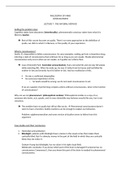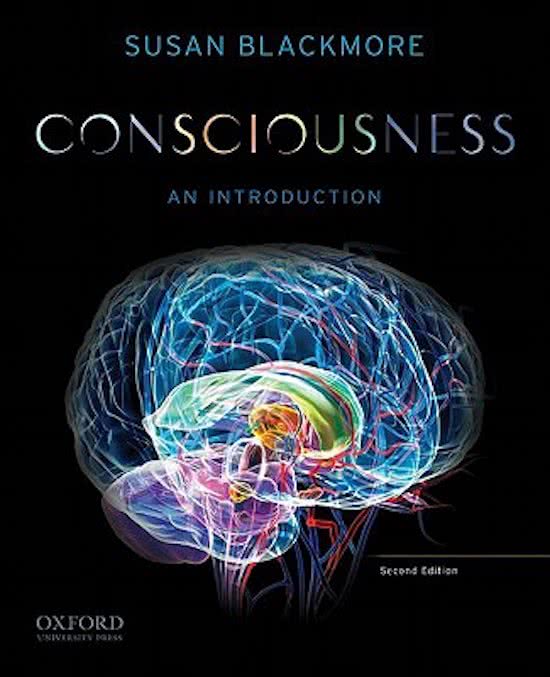PHILOSOPHY OF MIND
CONSCIOUSNESS
LECTURE 7 : THE NATURAL METHOD
Getting the problem clear
Cognitive states have aboutness (intentionality), phenomenally conscious states have what it is
likeness (qualia).
Rest of this course focusses on qualia. There’s so many approaches to the definition of
qualia, we stick to what it is likeness, or the quality of your experience.
What is consciousness?
Searle: it’s impossible to define consciousness. He uses examples: waking up from a dreamless sleep,
entering a state of consciousness that continues for as long as you are awake. Maybe phenomenal
consciousness only occurs when we are awake, as it guides our actions then.
Case of Kenneth Park: homicidal somnambulism. Had a stressful life and one day fell asleep
while watching SNL. When he woke up, he was 23 miles from his house and had killed his
mother-in-law and severely hurt his father-in-law. Had no recollection of this.
He was a confirmed sleepwalker.
No conscious experience of this.
o So Searle would be wrong: we do not need consciousness to act.
If we are capable of performing complex actions without consciousness, what is the function
of consciousness?
Why are we not phenomenal / philosophical zombies? Philosophical zombie is a copy of us;
someone who looks, acts, speaks, and in every detectible way behaves exactly like you, but is not
conscious.
The zombies have no qualia but still act like we do. Phenomenal consciousness doesn’t
seem to have a function; bodily reactions can be enough to explain our behaviors.
Problem: epiphenomenalism and some version of dualism seem to follow from this
argument.
Case studies and their conclusions
1. Homicidal somnambulism
2. Blindsight: patients with blindsight have a lesion in the visual cortex that makes them
cortically blind. But if a stimulus moves in the part of the field in which they are cortically
blind, they do notice it.
Graham Young has blindsight, has no vision in his right visual field.
Weiskrantz concludes: if you know which part of the brain is damaged if someone has no
consciousness (‘awareness’), then you know this part of the brain is needed for phenomenal
consciousness.
, Young has a lesion in the evolutionary younger path, from the eyes to the visual cortex.
However, there is an evolutionary older path that processes visual information without
consciousness.
Blindsight patient is more or less a philosophical zombie: has vision without
consciousness. He is an automaton who can ‘see’ functionally but has none of the visual
qualia that go with normal seeing
o Young is not visually a phenomenal zombie as he still has visual experiences in his
left visual field. He also claims not to have experience, a zombie would never do
that.
Zombies would perform just as well at detecting and reporting stimuli as
humans, they simply do not experience it. Impaired people are not as successful.
Methodological starting points
Four (related) starting points:
1. Naturalism
2. The natural method
3. Neo-Darwinist theory of evolution
4. Induction
Naturalism is the philosophical idea that we have to use the scientific method to solve problem, for it
is our best method, and that we take its results seriously. This has consequences for the answers we
might find to questions, also when these are traditionally regarded as philosophical questions.
Consciousness is a biological feature of human and certain animal brains. It is as much part of
the natural biological order as any other biological feature such as photosynthesis, etc.
The natural method: described by Flanagan, who argues we need an interdisciplinary method to
solve problems related to consciousness.
Start by treating three different lines of analysis with
equal respect. Give phenomenology its due. Listen
carefully to what individuals have to say about how
things seem. Also, let the psychologists and
cognitive scientists have their say. Listen carefully to
their description about how mental life works and
what jobs consciousness has, if any, in its overall
economy. Finally, listen carefully to what the
neurologists say about how consciousness mental
events of different sorts are realized, and examine
the fit between their stories and the phenomenal
and psychological stories.
Phenomenology in this case only refers to the way we experience things, and what we report about
our experiences. It is not actually a method.
Example: Penfield homunculus
, If we would only look at the brain, we wouldn’t know it’s
function and there is no reason to think anyone is conscious.
Only using introspection would never lead to the discovery
that we need brains to be conscious. We need to combine
methods: the natural method.
Penfield found a correlation between brain stimulation and
the experience of bodily phenomena.
Neo-Darwinist theory of evolution: if we say consciousness does something, this has to be an
evolutionary function with respect to survival and production (or it is a harmless byproduct of such a
function).
Induction: it is possible that one type of experience has an evolutionary function, while another
might not have such a function. What we conclude based on individual case studies about
consciousness in general is never sure: this is the problem of induction. We have to make general
claims, based on empirical data, however this can mean these claims can be denied.
It’s the reasoning from one or more (but not all) cases in which A is B to the conclusion that
all A are B.
LECTURE 8 : PROJECTION HYPOTHESIS
Homo- and heterogeneous consciousness
We can say every experience has qualia, thus phenomenal consciousness is homogeneous. Flanagan
also claims phenomenal consciousness is heterogeneous: all experiences have different qualia.
Problem: if we draw this conclusion, and we want to know what consciousness is, we have
to establish that for every type of consciousness individually.
And; not all biological properties are adaptive: some are epiphenomena (Darwin concluded
evolution from natural selection as he saw artificial selection. AS can have side-effects, like
silver foxes).
In USSR coats were made of silver foxes – a wild species, thus more difficult than tame
animals which can be kept on farms. Artificial selection: only breed with non-biting
puppies.
Tameness had side-effects: smaller skull, black-white fur, started to bark, got floppy ears.
These effects can be explained by pleiotropy: whereby genes have more than one effect,
seemingly unconnected.
o So: when you observe a characteristic in an animal and ask what the Darwinian
survival value is, the characteristic may have changed along in evolution by some
other characteristic to which it is pleiotropically linked.
So there’s a danger in panadaptionism (seeing every trait as necessarily adaptive).





